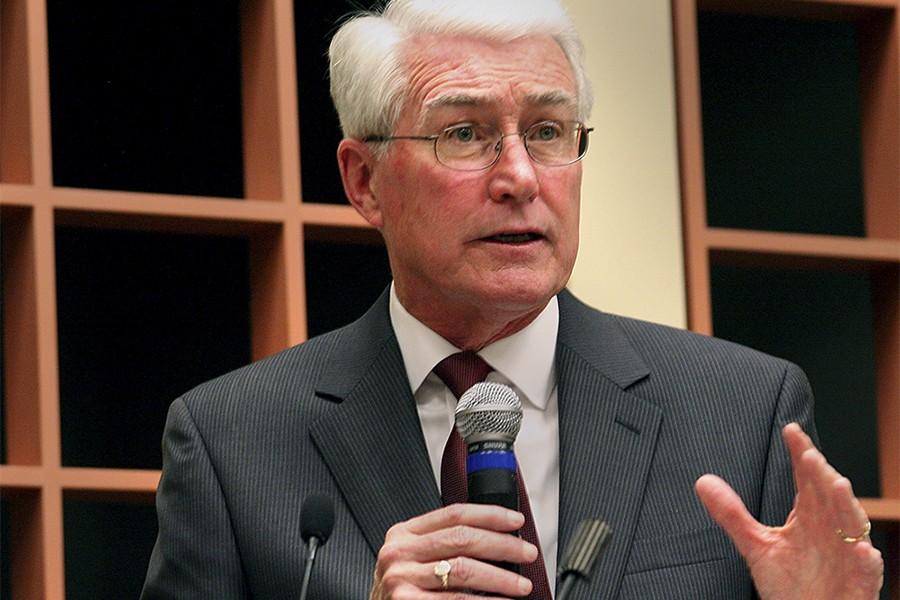Renewable Energy Plant won’t cause smoky skies
No smoke or smell will be emitted from the new Renewable Energy Center, which is slated to replace the current coal-burning steam plant in fall 2010.
The center will use a biomass gasification process to heat and cool the campus. A biomass is an organic material that can be used as a renewable resource. Wood chips are a widely available biomass, and will be the initial fuel source for the campus.
While the center will be using wood chips as fuel, the process used will not be like an open fire, said Gary Reed, director of facilities, planning and management.
“You won’t see a campfire smoke stream,” he said. “You won’t detect that sort of smoke coming out of our plant.”
The wood chips will be burned in an oxygen-deprived environment to control how the wood burns, said Ryan Siegel, campus energy and sustainability coordinator.
“When you normally have a campfire you’ll see the flame is not all blue,” Siegel said. “It tends to be yellow because it doesn’t have the full amount of oxygen it needs.”
The gasification process used in the center will control the oxygen for complete combustion of the gas. In a campfire, synthetic gas can be seen in the little spot between the flame and the wood. Through the gasification process, this gas is siphoned off and then burned in a standard water tube boiler.
“It is very similar to a natural gas fire process,” Siegel said. “We’re just using wood to create the natural gas.”
To create that natural gas, trucks first have to come in off Route 130 and dump the wood chips into a fuel silo. As the boilers need fuel, augers will take the wood from the silo and bring it into the immediate fuel storage directly attached to the gasifier.
The wood chips are then brought into a chamber and heated at a high temperature. This drives off all the combustible material in the wood. The wood turns to gas.
The wood doesn’t burst into flame because the chamber is kept at a low oxygen level, Reed said.
The gas vapor that is ready to burn then goes into a boiler.
“We allow extra oxygen to mix with that gas stream at a very high temperature and at that point it bursts into flame,” Reed said.
After the fuel passes through the boiler, the emissions go through an electrostatic precipitator, which is designed to catch any dust particles, or particulate matter that may have gotten through the previous steps in the gasification process.
“Anything that comes through that boiler will be captured in the electro-static precipitator as a dust so that coming out the chimney there will be no visible emissions,” Reed said.
An available fuel
Trees are more readily available compared to traditional fuels such as natural gas or coal that can’t just be produced with the same frequency, Siegel said. The wood chips used will be two-inch virgin wood chips coming from the logging industry.
The university will be purchasing the chips from an aggregator, he said. A number of lumber industries will come together and Eastern will receive their chips from there.
The chips and trimmings from logging operations are considered a waste. These small chips cannot be made into any kind of lumber.
Reed said wood is an available option in the family of biomass fuels.
“It’s easy to handle. It’s readily plentiful. It’s reasonably priced,” Reed said.
The cost to use wood as a fuel is approximately half the price of coal, which Eastern currently uses, Reed said. Wood is also approximately one-sixth of the price of natural gas, which he said makes it a tremendously attractive option cost-wise.
Siegel said using wood chips would not be a threat to trees because the logging industry is conscientious to replant trees and the wood chips are just a waste product from the lumber industry.
“We can use as fuel what the logging industry would have otherwise discarded,” Siegel said. “There’s no really net impact to the forestry.”
Eastern will initially be permitted to use just the wood chips.
“We are planning on over time working with the EPA (U.S. Environmental Protection Agency) to permit additional fuels as the agricultural biomass market becomes more developed,” Siegel said.
Other biomass options for Eastern would be tree trimmings from the city and utilities, or switch grass, he said.
“If other people have other things that they would be interested in, we would certainly take a look and see if there was potential viability with those as well,” Siegel said.
Reed said biomass is basically just a mass of biological material that can be consumed and burned that would otherwise biodegrade. Examples he gave were corn stalks lying in the cornfields and grasses that grow and die year to year and go back into the environment.
“If you take that naturally occurring decomposition that happens all the time, and you can convert it to usable fuel, then that’s why there’s such an attraction to that methodology,” Reed said. “There’s a number of biomass products that could be consumed for energy rather than just letting natural degradation go with no gain to the carbon and to the environment.”
A usable waste product
The only solid waste product that comes out of the center will be soluble potash (a chemical compound made of potassium and carbon). This potash can be used as valuable fertilizer for agricultural purposes. There are no hazardous products coming out of the potash.
“That we’ll be likely to spread on our fields, or we may find people in the community who want to get the potash to themselves,” Siegel said.
The waste equates to 1 percent by volume of the consumed wood chips. Reed said if 100 buckets of chips were used in a day, one bucket of potash would be left.
Siegel said on a day of full capacity, about five cubic yards of potash could be produced. Full capacity generally happens only in the winter, he said.
“That’s significantly less than the amount of ash we produce currently with the coal operation,” Siegel said. “A five-cubic yard dumpster is about the size of the dumpster that the stadium has.”
For a full day of fuel, Siegel said that is a small amount.
The waste will be captured in fully enclosed dumpsters so potash will not be flying around everywhere either, he said.
A reliable process
Before choosing the Renewable Energy Center, Reed said they first visited several biomass sites in Vermont.
He said Vermont had about four or five different sites. One was at an Army post, another at a school and another at a courthouse.
“We investigated and considered where they were placed and how they operated and talked to the personnel responsible for operating,” Reed said.
He said the operators across the board indicated their biomass plants were easy to operate and not difficult to keep and maintain.
Reed said the variety of locations with sites was impressive. The gasifier on the courthouse was located in a downtown area.
“Its not like a regular power plant that you’d need to put out way at the edge, in the country,” Reed said. “It’s something that can be combatable with close living. We were pleased with that because we’re sensitive to the campus and the neighborhood that we’re going to establish this unit in.”
Reed said there are many other wood gasifiers operating in Wisconsin, Canada and Europe.
“The process isn’t new, but it’s very reliable, extremely simple and very environmentally soft,” Reed said.
Emily Zulz can be reached at 581-7942 or at eazulz@eiu.edu.


































































